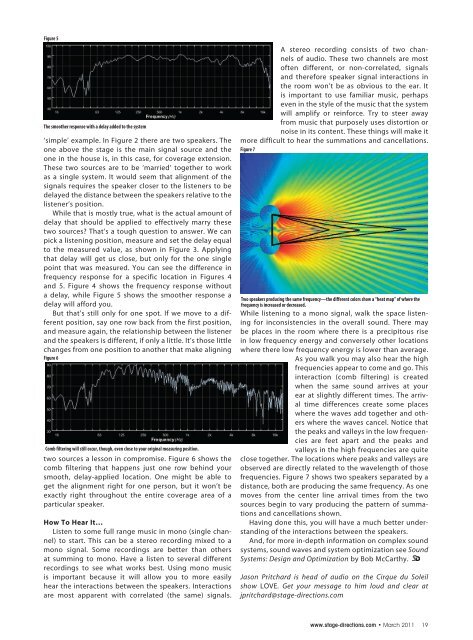Country Teamwork - Stage Directions Magazine
Country Teamwork - Stage Directions Magazine
Country Teamwork - Stage Directions Magazine
- No tags were found...
Create successful ePaper yourself
Turn your PDF publications into a flip-book with our unique Google optimized e-Paper software.
Figure 5The smoother response with a delay added to the system‘simple’ example. In Figure 2 there are two speakers. Theone above the stage is the main signal source and theone in the house is, in this case, for coverage extension.These two sources are to be ‘married’ together to workas a single system. It would seem that alignment of thesignals requires the speaker closer to the listeners to bedelayed the distance between the speakers relative to thelistener’s position.While that is mostly true, what is the actual amount ofdelay that should be applied to effectively marry thesetwo sources? That’s a tough question to answer. We canpick a listening position, measure and set the delay equalto the measured value, as shown in Figure 3. Applyingthat delay will get us close, but only for the one singlepoint that was measured. You can see the difference infrequency response for a specific location in Figures 4and 5. Figure 4 shows the frequency response withouta delay, while Figure 5 shows the smoother response adelay will afford you.But that’s still only for one spot. If we move to a differentposition, say one row back from the first position,and measure again, the relationship between the listenerand the speakers is different, if only a little. It’s those littlechanges from one position to another that make aligningFigure 6Comb filtering will still occur, though, even close to your original measuring position.two sources a lesson in compromise. Figure 6 shows thecomb filtering that happens just one row behind yoursmooth, delay-applied location. One might be able toget the alignment right for one person, but it won’t beexactly right throughout the entire coverage area of aparticular speaker.How To Hear It…Listen to some full range music in mono (single channel)to start. This can be a stereo recording mixed to amono signal. Some recordings are better than othersat summing to mono. Have a listen to several differentrecordings to see what works best. Using mono musicis important because it will allow you to more easilyhear the interactions between the speakers. Interactionsare most apparent with correlated (the same) signals.A stereo recording consists of two channelsof audio. These two channels are mostoften different, or non-correlated, signalsand therefore speaker signal interactions inthe room won’t be as obvious to the ear. Itis important to use familiar music, perhapseven in the style of the music that the systemwill amplify or reinforce. Try to steer awayfrom music that purposely uses distortion ornoise in its content. These things will make itmore difficult to hear the summations and cancellations.Figure 7Two speakers producing the same frequency—the different colors show a “heat map” of where thefrequency is increased or decreased.While listening to a mono signal, walk the space listeningfor inconsistencies in the overall sound. There maybe places in the room where there is a precipitous risein low frequency energy and conversely other locationswhere there low frequency energy is lower than average.As you walk you may also hear the highfrequencies appear to come and go. Thisinteraction (comb filtering) is createdwhen the same sound arrives at yourear at slightly different times. The arrivaltime differences create some placeswhere the waves add together and otherswhere the waves cancel. Notice thatthe peaks and valleys in the low frequenciesare feet apart and the peaks andvalleys in the high frequencies are quiteclose together. The locations where peaks and valleys areobserved are directly related to the wavelength of thosefrequencies. Figure 7 shows two speakers separated by adistance, both are producing the same frequency. As onemoves from the center line arrival times from the twosources begin to vary producing the pattern of summationsand cancellations shown.Having done this, you will have a much better understandingof the interactions between the speakers.And, for more in-depth information on complex soundsystems, sound waves and system optimization see SoundSystems: Design and Optimization by Bob McCarthy.Jason Pritchard is head of audio on the Cirque du Soleilshow LOVE. Get your message to him loud and clear atjpritchard@stage-directions.comwww.stage-directions.com • March 2011 19
















